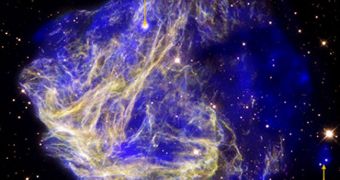Supernova explosions are generally accepted to be among the most violent phenomena taking place in the Universe. They take place when massive stars reach the end of their burning cycle, and exhaust their hydrogen supply. As they explode, they produce so much energy that their light signature briefly outshines that of entire galaxies, as seen from Earth. The events leave behind structures called remnants, and recent studies on one such formation have revealed the existence of a cosmic bullet-like structure exiting the remnant at incredibly-high speeds, Space reports.
The interesting feature is seen in this new image radiating from the supernova remnants. The photo was collected using the renowned Chandra X-ray Observatory, one of the four instruments built by NASA for its Great Observatories program. The telescope is extremely well suited to conduct investigations in these wavelengths, and the amount of detail in this image has made experts reconsider some of the basic knowledge they had about the N49 supernova remnant. The structure is located relatively nearby, in the Large Magellanic Cloud, one of our closest-neighboring galaxies.
The orientation of the bullet is perfectly aligned with at a soft gamma-ray repeater (SGR). This is an object that emits in the gamma-ray and X-ray region of the electromagnetic spectrum. As the name implies, it does so at regular intervals. Explaining SGR was never simple, but most astronomers now accept that they are actually neutron stars, which appeared after a massive star collapsed. Following supernova explosions, in which a massive star collapses in on itself, and shed the outer layers of its atmosphere, some of the potential outcomes include the appearance of black holes, pulsars, neutron stars and so on.
But the new Chandra observations would seem to indicate that the SGR in this photo (the point source) is actually not located inside the supernova remnant. Speaking at the 216th meeting of the American Astronomical Society (AAS 2010), held in Miami, Florida, experts said that that vast amount of gas found lying in front of the SGR could imply that the object is located beyond the supernova remnant. Its apparent inclusion in the larger formation could be promoted by the fact that it is projected along our line-of-sight, which tricked astronomers into believing it was located inside the remnant. However, additional studies are needed before the idea can be verified.

 14 DAY TRIAL //
14 DAY TRIAL //